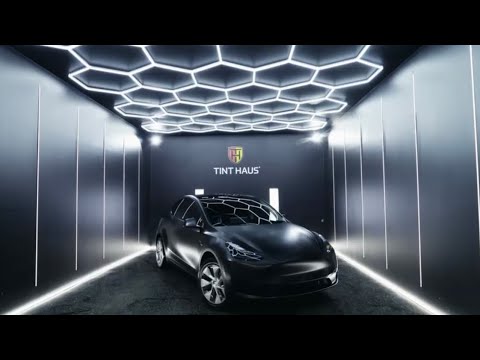Many car owners invest in paint protection to preserve that brand-new shine, but how long does paint protection last? Whether you’ve chosen Paint Protection Film (PPF), ceramic coating, or graphene coating, longevity depends on the product quality, installation, and care routine.
At Tint Haus, we apply only premium, professionally installed protection systems designed to perform in Australia’s harsh UV conditions. Here’s a breakdown of how long each option lasts and how to make your investment go the distance.
Why Paint Protection Matters
According to Australia’s Bureau of Meteorology UV Index, Sydney experiences extreme UV radiation for most of the year, making professional paint protection essential. Sydney’s climate can be brutal on modern paintwork. Constant UV exposure, salty coastal air, and fine road debris can quickly dull even the newest car. Without protection, clear coats oxidise, fade, and lose gloss — and once that happens, it’s costly to reverse.
Installing paint protection early acts like a defensive barrier that seals and shields your paint from environmental attack while making washing and maintenance easier.
Paint Protection Film (PPF): Lifespan & Care
Paint Protection Film is one of the most durable ways to make your paint protection last for years. It’s a transparent urethane film applied to high-impact areas such as bonnets, bumpers, and mirrors. Paint Protection Film is a transparent urethane film applied to panels most exposed to impact — bonnets, bumpers, and mirrors.
Typical lifespan: 7–10 years.
Why it lasts:
- High-quality films include UV inhibitors and “self-healing” top layers.
- When installed correctly, PPF bonds smoothly to the paint surface, preventing lift or yellowing.
- It resists stone chips, scratches, and chemical etching far better than any coating alone.
Care tips:
- Hand-wash only with pH-neutral soap.
- Avoid pressure-washer edges.
- Apply a dedicated PPF sealant every 6 months for extra gloss.
Ceramic Coating: Lifespan & Maintenance
To make your paint protection last as long as possible, ceramic coatings offer a strong chemical bond that shields the clear coat from UV rays, oxidation, and grime. These liquid polymers create a sleek, hydrophobic surface that enhances gloss while protecting against contaminants. Ceramic coatings are liquid polymers that chemically bond with the clear coat to create a glass-like, hydrophobic finish.
Typical lifespan: 2–5 years depending on formula and maintenance.
Strengths:
- Excellent resistance to UV, oxidation, and light scratching.
- Water and dirt slide off easily, reducing wash frequency.
- Enhances depth and gloss, keeping paint looking “wet”.
Care tips:
- Wash fortnightly using the two-bucket method.
- Use microfibre cloths only; never automatic brushes.
- Top up with a ceramic booster spray every few months to refresh hydrophobic performance.
Graphene Coating: The New Generation
If you want your paint protection to last even longer, graphene coatings are the next evolution. They combine ceramic strength with enhanced resistance to water spotting and heat, making them one of the most advanced options available today. Graphene coatings build on ceramic technology by adding graphene — an ultra-thin carbon lattice stronger than steel yet incredibly light.
Typical lifespan: 5–7 years.
Advantages over ceramic:
- Greater resistance to water spotting and heat.
- Superior anti-static behaviour, meaning less dust attraction.
- Reduced surface tension, so grime and bird droppings clean off more easily.
Maintenance: identical to ceramic, but graphene formulas require fewer top-ups thanks to their stronger molecular bond.
What Affects Longevity?
Even the best protection will age faster if neglected. Factors include:
- Washing habits: harsh detergents strip coatings prematurely.
- Storage: outdoor parking exposes paint to constant UV.
- Driving conditions: gravel roads and heavy rain shorten lifespan.
- Installer quality: poor preparation means poor bonding.
Professional installation is non-negotiable if you want your protection to perform as promised. At Tint Haus, surfaces are meticulously decontaminated and corrected before any film or coating touches the paint.
How to Extend the Life of Paint Protection
- Regular gentle washing: keeps contaminants from embedding.
- Avoid waxes containing abrasives or silicone.
- Book annual inspections: we can check bonding integrity and re-seal weak spots.
- Apply protective top-coats: our maintenance packages refresh gloss and hydrophobicity.
When to Re-Apply or Replace
- PPF: Replace when edges lift, yellowing appears, or major damage occurs.
- Ceramic/Graphene: Re-coat once hydrophobic behaviour drops noticeably or after machine polishing.
Proper maintenance can double effective lifespan — many Tint Haus clients see coatings last far beyond manufacturer ratings.
Conclusion
The short answer: paint protection lasts anywhere from 2 to 10 years, depending on which option you choose and how you care for it.
PPF delivers the longest, most impact-resistant protection. Ceramic coating offers the best balance of gloss and maintenance ease. Graphene coating provides cutting-edge durability and heat resistance.
No matter which route you take, professional installation and regular upkeep are what separate a short-term shine from years of lasting brilliance.

